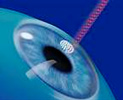eye laser
You may find details on eye laser and laser implantation here.
1) laser eye surgery (kornea methods):
There are two different cornea methods.
- Lasik
- Lasek
a) LASIK Laser-in-situ Keratomileusis
Lasik (Laser in Situ Keratomileusis) means replacing the structure within the cornea layer by using laser technology. There have been 12 million ophthalmological treatments with this method since 1990. Current Lasik technology is able to treat 90% of optical disorders.
This treatment method applied by the most modern and the most sensitive techniques considered to be painless has become more and more popular in the world as it provides a quick recovery and wide areas of application. In general, the less optical disorder you have, the more successful treatment is. In practice, the Lasik technology is applied to cases with minor or medium amounts of myopia as well as minor amounts of hyperopia and astigmatism. Lasik treatment is an ambulatory treatment. Staying in hospital is not required.
Tissue ablation lasts for 30 or 90 seconds. Due to a system monitoring eye movements, we are able to examine your eye at all times. When you move your eyes randomly, thousands of examinations can be done within a second thanks to laser beams.
Significant points in LASIK treatment:
- Results are highly sensitive and permanent.
- Correction of sight deficiency takes place in inner cornea.
- There is no pain before or after the surgery.
- It has two different Lasik applications:
- Micro-ceratome standard lasik application
- Laser ceratome and femto lasik application
a1) Micro-ceratome standard lasik
Before the application, the doctor cleans the eyelid and then uses an eyelid holder in order to have a fixed eyelid.
This method includes ablation of a thin flap from the top surface of the cornea via the computer-controlled knife of micro-ceratome; until there is a very thin connection between the flap and the cornea.


a1a) Standard LASIK phases
This method includes ablation of a thin flap from the top surface of the cornea via the computer-controlled knife of micro-ceratome; until there is a very thin connection between the flap and the cornea. You feel darkness and a slight pressure for a very short period of time, 20 seconds.
Then, this flap is removed like a lid and after that, all the procedure controlled by the computer is monitored by the doctor over microscope.




Ablation is applied to the inner tissue of the cornea via Excimer laser device, based on the sight deficiency. You hear these laser beamings but you do not feel them!
Following that procedure, cornea lid is replaced via a slight pressure. This cornea flap does not required stitches; instead it reattaches itself to its previous position and within a couple of days, it is reattached to the tissue completely.
After a short period of resting in the waiting room, doctor makes one last check.
A slightly blurry vision and slight lacrimation is very normal after the surgical operation. After a couple of seconds, enough sight is restored and that means you no longer need to use eyeglasses or contact lenses. After a period of 4 or 8 weeks, eyesight is usually stabilized.




a2) Laser ceratome Intralase method, Femto Lasik
Femto lasik called femto second lasik, “Lasik laser” or “intra lasik” is a new method in laser eye treatment for myopia, hypermetropia and astigmatism.
In femto lasik method, femto second laser is used in addition to excimer laser. So far, in laser lasik surgeries, a thin flap from the cornea has been opened backwards via ablation, with the use of micro-ceratome. In modern femto lasik technique, femto second laser replaces micro-ceratome and that makes it possible to have laser lasik eye treatment without the use of mechanical devices.
After laser ablation, the top flap of the cornea is opened backwards and the sight deficiency is corrected through an ablation of cornea layer with an excimer laser device, as in the case of laser lasik surgeries.
The new method has advantages and disadvantages. After a detailed examination in hospital, it is decided whether femto lasik application will have any surplus value for your eye.
b) Lasek (Laser Epithelial Keratomileusis)
Lasek application is a method that has to be considered as a technique between PRK and LASİK.
It is applicable to those eyes with a very thin cornea that is impossible to treat and eyes with very low sight deficiency such as 4 dioptre myopia and astigmatism as well as 3.5 dioptre hypermetropia and astigmatism.
Unlike Lasik operations, it not the back but the front of the cornea that is treated. Similarly, a cornea flap is removed via a solution including alcohol and after the treatment, it is placed back. Here, it fixes itself to its original spot.
d) Monovision (against reading eyeglasses)
In monovision application, one eye is slightly corrected in order to have a better reading. The principle of monovision method is based on correcting one eye for looking at a distance and the other eye for looking at objects that are close. Generally, in this system, there is a close and distant vision at the same time and brain selects the image it needs about various unconscious images. As centring about close and distant objects has to be very delicate, it takes some time to get used to this method.
75 per cent of the patients feel themselves very comfortable after a monovision operation. This treatment is first tested in order to see which patient can actually be adapted to the treatment, via contact lenses.
e) Supracor Lasik (against reading eyeglasses)
The SUPRACOR procedure is based upon the well-known, commonly used LASIK laser eye treatment for vision correction. The SUPRACOR laser procedure is quick, safe, and effective*.
The procedure can treat a wide range of presbyopic patients, and may also be suitable for patients who have previously undergone a LASIK procedure. The procedure provides excellent distance, intermediate and near vision, whilst maintaining a high quality of vision.
The SUPRACOR procedure is performed using a high-tech laser system called the TECHNOLAS Excimer Workstation which is made by a German company called Technolas Perfect Vision GmbH. This excimer laser is used to precisely reshape the cornea to restore near vision and simultaneously treat hyperopia or myopia, if necessary.
The treatment involves first creating a thin flap on the surface of the eye with either a femtosecond laser or a microkeratome. This upper layer or flap is then moved to one side to allow the surgeon access to the cornea. Then the surgeon uses the excimer laser to accurately reshape the cornea and treat the presbyopia.
For optimum safety, the excimer laser uses the state-of-the-art Advanced Control Eye-tracking (ACE) technology. Using iris recognition technology, this dynamic tracker continually tracks eye movements, rotation and pupil shift and simultanteously adjusts the laser beam to ensure the laser is accurately delivered during the entire procedure.
At the end of the procedure, the surgeon repositions the flap to its original position. This allows the eye to naturally heal.
The whole procedure takes only a few minutes.
f) Kamra Inlay Lenses (against reading eyeglasses)
The KAMRA inlay is an intra-corneal inlay designed to create a small aperture effect, allowing the eye to see near and intermediate objects more clearly. By applying the “depth-of-focus”; principle commonly used in photography, the KAMRA inlay controls light transmission allowing only central rays to reach the retina through a fixed 1.6 mm aperture. This outpatient procedure is completed by implanting the cornea inlay under a LASIK-type flap or in a corneal pocket. Patients who have undergone this procedure are once again seeing numbers on a mobile device, reading text messages, and checking the time on a wristwatch with ease.
The KAMRA inlay received CE mark for use in the European Union in 2005 and is an investigational device under IDE (Investigational Device Exemption) in the United States. The device provides a revolutionary treatment option for near vision loss, or presbyopia, which affects 1.5 billion people worldwide.
With over 1,000 participants in worldwide clinical trials and nearly a decade of research and development, the KAMRA inlay is proven to:
1. Offer natural vision after 40
2. Restore everyday near and intermediate vision and reduce dependency on reading glasses.
3. Maintain distance vision.
4. The KAMRA inlay is an excellent option for all presbyopes regardless of whether they are nearsighted, farsighted, or have had prior surgery such as LASIK or cataract removal.
2) Lens implantation method
Cornea application reaches to natural limits that must not be exceed in high sigh deficiency cases. In myopia, this starts at -10 dioptre and in case of hypermetropia, it starts at +4. This method is also used against presbyopia.
The method has three sections:
- Intraocular lenses (Phakic OIL)
- Intracorneal ring segments (INTACTS)
- And multifocal lenses in presbyopia


2a) Intraocular lenses
Inner eye lenses implanted into the eye
Sight deficiency in eyes with very high level of myopia or hypermetropia and that are not available for laser operation due to a very thin cornea layer can actually be corrected via FAKIK-IOL surgery.
Based on a lasik laser surgery for correcting possible cornea deficiencies, sight deficiencies such as myopia between 7 and 25 dioptre and a hypermetropia between 5 and 13 dioptre.
2a1) Area of application
FAKIK-IOL surgeries are applicable to those who are older than 18 and to patients suffering from glaucoma (high eye pressure), some retina deficiencies, cataract or glaucoma (ophthalmia). The decision on the applicability of this surgery can actually be made after a detailed examination where the degree of sight deficiency and growth of pupil in the dark and the exact shape of the cornea are identified.
2a2) Surgery
FAKIK-IOL surgery provides absolute results in patients with high level of myopia and hypermetropia. Only the best artificial eye lenses are used for these applications, in our hospital. Artificial lenses implanted onto the eye sustains its adaptation and optical features for a life-time. After surgery, it is not possible to detect this artificial lenses, even the patient’s himself does not perceive it as a foreign material in his eye.
2b) Intracorneal ring segments (Intacs)
Intacs are tiny and transparent tissues implanted on the cornea in order to treat myopia; with a semilunar shape.
2b1) Area of application
For patients with a myopia between 1 and 4 dioptre and suffering from a degenerative cornea disease in addition to a very thin cornea for eye laser surgery; this treatment is applied in order to correct the sight deficiency as well as to slow down or even to stop the incurable disease that is currently in an advanced phase.
2b2) Surgery
An INTACS surgery takes approximately 10 minutes for a single eye; and for this surgery, it is sometimes required to wait for two days before the surgery is operated on the other eye. The eye treated with surgery is kept in bandages for a single day. In the meantime, patient feels no pain. After a while, bandage can be removed and the patients start to have a clear vision without the use of any visual aid.
2c) Multifocal lenses in Presbyopia
Presbyopia adjustments, known as hypermetropia brought by old age where the eye loses its flexibility in adjusting the eye for close-range, are virtually made via these artificial lenses.
In multifocal lenses, concentric rings in various widths are “superimposed over each other” and thus various fields of vision and focal points are formed so that the eye chooses its unconscious and accurate field vision.
Multifocal lenses have been available for a long time and recently, there have been significant improvements.
